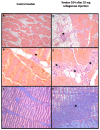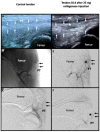Collagenase-Induced Patellar Tendinopathy with Neovascularization: First Results towards a Piglet Model of Musculoskeletal Embolization
- PMID: 35052682
- PMCID: PMC8773136
- DOI: 10.3390/biomedicines10010002
Collagenase-Induced Patellar Tendinopathy with Neovascularization: First Results towards a Piglet Model of Musculoskeletal Embolization
Abstract
Background: Therapeutic strategies targeting neovessels responsible for musculoskeletal chronic pain have emerged, including neovessels embolization. Our study aimed to develop a large animal model of patellar tendinopathy with neovascularization.
Methods: Nine 3-month-old male piglets (18 patellar tendons) received percutaneous injections of increasing doses of collagenase (0 to 50 mg) at day 0 (D0). Tendinopathy was evaluated by ultrasound (D7 and D14). Neovascularization was evaluated visually and on angiographies. Bonar score was used for histological analysis (D14). Correlations were evaluated using Spearman's rank (Rs) test.
Results: Research protocol was well tolerated. All tendons were enlarged with a median increase of 31.58% [25-40.28] at D7 (p = 0.244) at D7 and 57.52% [48.41-91.45] at D14 (p = 0.065). Tendons with collagenase injection had more hypoechoic changes, with one tendon rupture (p = 0.012). Neovascularization was reported above 5 mg collagenase (p < 0.01) at D7 and D14 with dose-related neovessels induction (Rs = 0.8, p < 0.001). The Bonar score increased above 5 mg collagenase, correlated with the dose (Rs = 0.666, p = 0.003).
Conclusions: The study shows the feasibility, safety and reproducibility of this new large animal model of patellar tendinopathy with neovascularization after collagenase injection. It will allow studying new treatments on direct embolization of neovessels by endovascular approach.
Keywords: animal model; embolization; neovascularization; patellar tendon; tendinopathy.
Conflict of interest statement
The authors declare no conflict of interest.
Figures



References
Grants and funding
LinkOut - more resources
Full Text Sources

